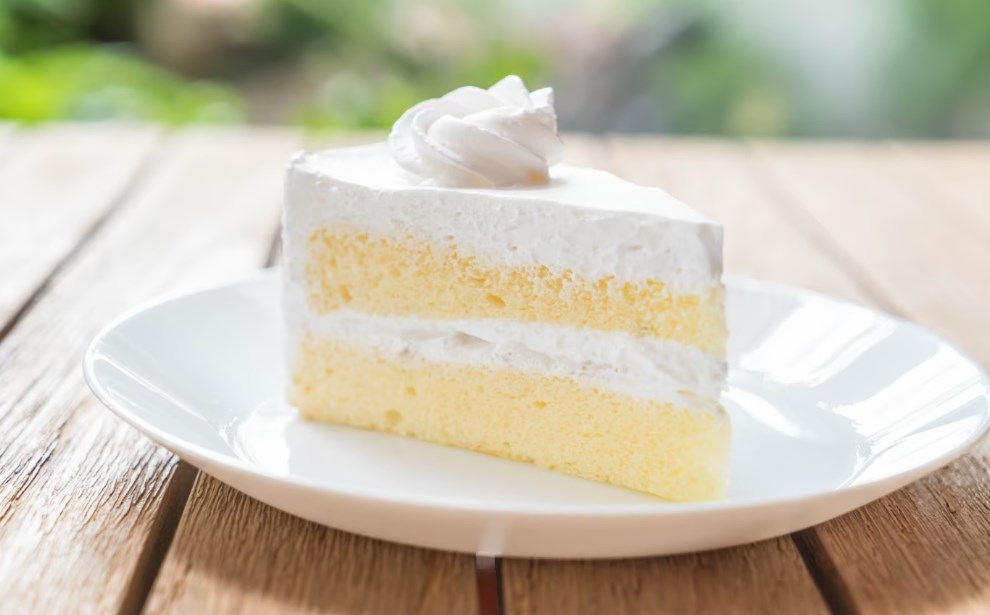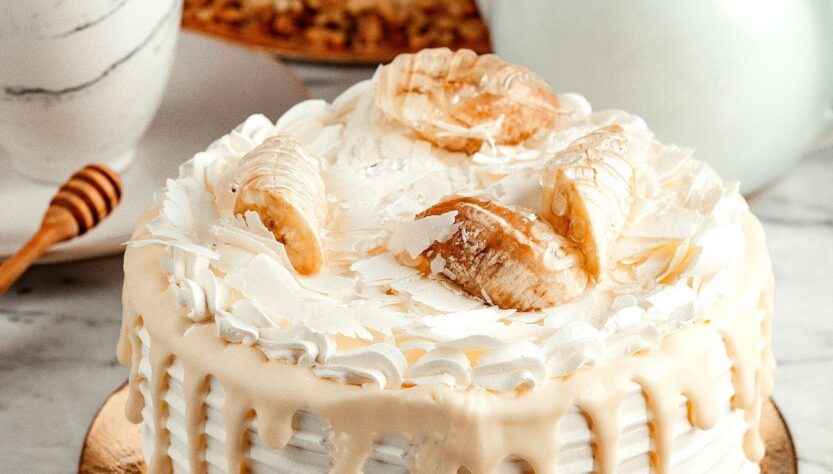French Vanilla Cake is often mistaken for a basic treat, but this delectable confection stands as a testament to the nuanced beauty of vanilla. This classic, renowned for its softness and flavor, has been the cornerstone of numerous celebrations.
Join us in exploring its roots, intricacies, and the techniques that bring it to life.
The Essense of the French Vanilla Cake
A foolproof French Vanilla creation promises a soft, airy, and rich essence. While every culinary enthusiast dreams of mastering a dependable vanilla confection, the French Vanilla variant is poised to become the crown jewel in your baking repertoire.
Vanilla’s elegance is often understated, yet it’s far from monotonous. It presents a multifaceted taste that serves as the backbone for a plethora of gourmet sweets.
The French Vanilla variant isn’t just a favorite for celebratory events like birthdays and weddings due to its universal appeal. It boasts adaptability, pairing harmoniously with various frostings and fillings, making it a beloved choice.

This signature French vanilla concoction has been my cornerstone for renowned desserts, such as the Custard Fusion and the Tropical Mango Delight. Its distinctive preparation method, known as the reverse creaming, ensures an unparalleled soft and luxurious mouthfeel. The moment you experience its velvety slice, you’ll understand why it’s hailed as the quintessential vanilla delicacy.
Ingredients:
- Milk: This ingredient is pivotal in bestowing the sponge with a fluffy and silky consistency. Opt for whole milk for best results;
- Oil: A flavor-neutral oil like vegetable, canola, or sunflower ensures moistness;
- Flour: Cake flour is ideal for a delicate crumb, but general-purpose flour offers commendable results too;
- Sugar: Superfine sugar, known as caster sugar in some regions, brings out the vanilla’s exquisite taste;
- Eggs: Incorporate whole, preferably free-range, eggs for this creation;
- Butter: Ensure the unsalted variant is utilized, and it’s at a softened state before initiation;
- Vanilla: While the designation ‘French Vanilla’ doesn’t pertain to vanilla type, always opt for premium vanilla extract or paste to spotlight the essence.
Guidelines:
The unique reverse creaming technique, wherein dry elements meld with butter prior to sugar integration, might sound unconventional but assures an exquisite French vanilla confection.
- Preheat your oven to 335°F / 170°C. Prepare two 8-inch round pans with grease and line the base with parchment circles for effortless unmolding;
- Divide the milk into two parts – ½ cup (118g) and ¾ cup (177g);
- Combine the ½ cup milk with the oil and reserve;
- Blend the ¾ cup milk with eggs and vanilla, and set aside;
- In a mixer bowl, sift together flour, sugar, baking powder, and salt. Initiate at low speed;
- Gradually integrate butter until a breadcrumb-like consistency is achieved;
- Incorporate the oil-milk blend, gradually increasing the speed. Whisk consistently for two minutes;
- Ensure no residues cling to the sides before introducing the milk and egg fusion;
- Equally distribute the mixture into the pans and bake for 30-40 minutes or until a clean skewer test;
- Allow a cooling period within the pans for 30 minutes, then transfer to racks.
Once cooled, layer with your chosen frosting. Consider Russian Buttercream as an ideal complement, but other suggestions are provided later for this vanilla delicacy’s adornment.
Understanding the Cake
Contrary to what many believe, the term ‘French’ in French vanilla does not pertain to the origin of the vanilla, such as ‘Tahitian’ or ‘Madagascan’ vanilla. The term “French Vanilla” historically traces its roots to ice cream making, specifically the French style of creating ice cream with a custard base consisting of egg yolks and dairy. When it comes to cakes, French Vanilla indicates a vanilla cake that utilizes both egg yolks and whites, differentiating it from the usual white cake which typically employs only egg whites.
While many might associate the flavor of French vanilla cake with the convenient mixes from renowned brands like Betty Crocker, the truth is that a handcrafted vanilla cake made from scratch triumphs over a premixed version every time. Utilizing simple ingredients and easy-to-follow processes, this recipe promises the finest French vanilla cake experience.
Matching Frostings
The beauty of a vanilla cake lies in its versatility with flavors. If you’re looking for a traditional vanilla taste, vanilla buttercream is a go-to. However, there’s a wide array of buttercreams to explore:
- American Buttercream: This classic choice is delightfully sweet and offers a denser texture compared to other buttercream versions;
- Italian Meringue Buttercream: A refined choice, this frosting boasts a silky texture and is less sweet than its American counterpart. Though it requires a bit more effort to prepare;
- Russian Buttercream: A personal favorite, this buttercream captures the glossy texture of the Italian Meringue version but simplifies the process with only two essential ingredients;
- Furthermore, these frostings can be integrated with other ingredients to birth an array of delectable flavor combinations. A recent creation saw Russian Buttercream harmoniously blending with raspberry coulis, which was then used as a frosting for Raspberry Cupcakes.
Decorating the Delight
Your cake, your rules! But if you need inspiration, here’s a brief on how it can be done:
- Start by deciding the number of layers you want;
- To achieve a taller cake, you can slice each baked layer in half, creating four distinct layers;
- Ensure each layer is even by using tools like a cake leveler or a serrated knife;
- Layer the cake with your selected frosting;
- Apply a thin ‘crumb coat’ of frosting to the sides and top of the cake. Chill briefly;
- Generously frost the cake and attain smoothness with a spatula or bench scraper;
- Use a piping bag with a unique nozzle for detailed designs, like rosettes;
- Top it off with sprinkles or any other desired toppings.
Pro Tip: To achieve a flawless frosting finish, warm your spatula under hot water, quickly dry it, and then smooth out the frosting.
Versatility of the Recipe
This particular recipe can be adapted for:
- Multiple-layered cakes;
- Cupcakes;
- Bundt cakes. (Ensure it’s handled gently due to its delicate nature and remember to grease the bundt pan adequately.)
Required Tools:
- Either a stand mixer with a paddle attachment or an electric mixer;
- Two 8-inch cake pans.
Storing Your Creation
Unfrosted vanilla cakes, when wrapped in plastic and kept in an airtight container, can last between 3 to 5 days. The storage method for decorated cakes is contingent on the frosting used. Custard-based frostings require refrigeration, while others can be stored at room temperature in a sealed container.
French Vanilla Cake Recipe
Delight in this exquisite French Vanilla Cake, delivering softness, fluffiness, and the unmatched flavor of vanilla. It’s undeniably the quintessential cake recipe for every baker’s repertoire:
- Preparation Time: 15 minutes;
- Cooking Time: 35 minutes;
- Total Time: 50 minutes;
- Course: Dessert;
- Cuisine: American, French;
- Servings: 12 slices;
- Calories: 361 kcal per slice.
Equipment needed:
- Stand Mixer with paddle attachment;
- 2 8-inch cake pans.
Ingredients:
- 1 ¼ cups Milk (295g) – at room temperature;
- ⅓ cup Vegetable Oil (72g);
- 3 Eggs – at room temperature;
- 2.5 cups Cake Flour (312g);
- 2 sticks Butter (227g) – at room temperature;
- 1 ¾ cups White Sugar (350g);
- 1 ½ tablespoon Baking Powder;
- ½ teaspoon Salt;
- 1 tablespoon Vanilla Extract.
Instructions:
- Begin by preheating the oven to 335°F / 170°C. Properly grease the two 8-inch cake pans;
- Separate the milk into two parts: ½ cup (118g) and ¾ cup (177g);
- Combine the ½ cup of milk with the vegetable oil. Mix and set aside;
- Stir the remaining milk with eggs and vanilla extract. After whisking lightly, set this mixture aside;
- In your mixer’s bowl, add flour, sugar, baking powder, and salt. Begin mixing on a low setting using the paddle attachment;
- Gradually introduce the butter in small chunks, allowing each addition to blend for a few moments. The resulting mixture should resemble chunky breadcrumbs;
- Introduce the milk and oil combination, gradually increasing the mixer speed to medium. Allow this to blend for two precise minutes;
- Check for any residue and ensure an even mix. Resume mixing on a low setting;
- Slowly incorporate the milk and egg mixture until uniformly blended;
- Pour the batter equally into the cake pans. Bake for about 30-40 minutes. A clean skewer should indicate its readiness;
- Cool the cake in the pans for a minimum of 30 minutes. Later, transfer to a wire rack for further cooling;
- Once cooled, proceed to fill and frost the cake using your preferred frosting. For this particular version, Russian buttercream was used for a creamy and sweet vanilla texture.
Notes:
It’s essential for milk, butter, and eggs to be at room temperature to ensure proper incorporation of ingredients. Ideally, ingredients should be removed from the refrigerator about an hour before baking. However, this can differ based on local climates.
For a taller cake as shown in the pictures, a double batch of the recipe was used. From this, three-quarters were used for cake layers and the remaining quarter for cupcakes.
Nutritional Information (Per Slice):
- Calories: 361kcal;
- Carbohydrates: 50g;
- Protein: 4g;
- Total Fats: 17g (Saturated Fat: 10g, Polyunsaturated Fat: 1g, Monounsaturated Fat: 4g, Trans Fat: 1g);
- Cholesterol: 44mg;
- Sodium: 388mg;
- Potassium: 72mg;
- Fiber: 1g;
- Sugars: 31g;
- Vitamin A: 514IU;
- Calcium: 128mg;
- Iron: 0.4mg.
Conclusion
The allure of the French Vanilla Cake lies not just in its origin, but in its rich, custardy flavor, derived from the authentic French method of ice cream making. While the idea of “French vanilla” is often misconstrued, its true essence revolves around the custard base, a blend of egg yolks and milk or cream.
Beyond its decadent taste, the versatility of this cake is showcased in its pairing with a plethora of frostings, from the sweet American buttercream to the luxurious Italian Meringue and the simplistic Russian buttercream.
Decorating it remains an art, left to the baker’s imagination, but ensuring layers and the right frosting consistency is paramount. And while the cake is undeniably a showstopper, its creation process can be enriched with techniques like the reverse creaming method, which emphasizes texture and consistency.
Whether you’re crafting this cake from scratch or seeking the perfect frosting companion, remember that its essence lies in the balance of ingredients, method, and of course, love.
FAQ
The reverse creaming technique is a unique method for mixing cake ingredients. Traditionally, cakes begin with creaming butter and sugar until achieving a fluffy consistency, followed by adding eggs, vanilla, flour, and milk. The reverse creaming method, however, starts by integrating butter into the dry ingredients, including flour. This approach minimizes gluten formation, ensuring the cake remains tender and fluffy. A noticeable advantage of this method is that cakes often emerge flatter and devoid of a pronounced dome.
